brake sensor Hyundai Elantra 2018 Owner's Manual
[x] Cancel search | Manufacturer: HYUNDAI, Model Year: 2018, Model line: Elantra, Model: Hyundai Elantra 2018Pages: 526, PDF Size: 17.2 MB
Page 74 of 526
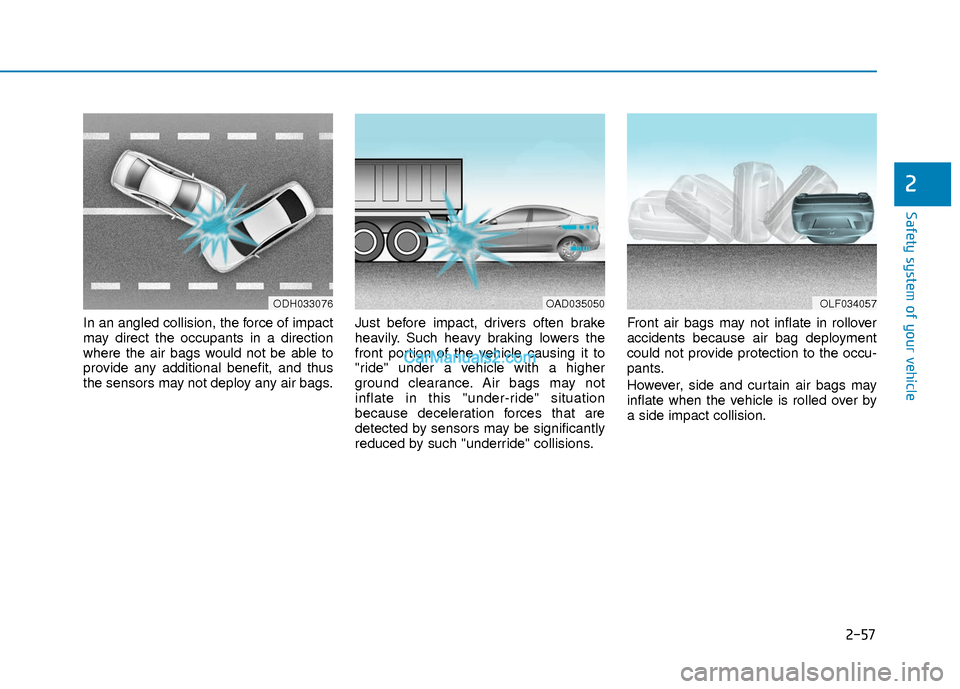
2-57
Safety system of your vehicle
2
In an angled collision, the force of impact
may direct the occupants in a direction
where the air bags would not be able to
provide any additional benefit, and thus
the sensors may not deploy any air bags.Just before impact, drivers often brake
heavily. Such heavy braking lowers the
front portion of the vehicle causing it to
"ride" under a vehicle with a higher
ground clearance. Air bags may not
inflate in this "under-ride" situation
because deceleration forces that are
detected by sensors may be significantly
reduced by such "underride" collisions.Front air bags may not inflate in rollover
accidents because air bag deployment
could not provide protection to the occu-
pants.
However, side and curtain air bags may
inflate when the vehicle is rolled over by
a side impact collision.
ODH033076OLF034057OAD035050
Page 143 of 526
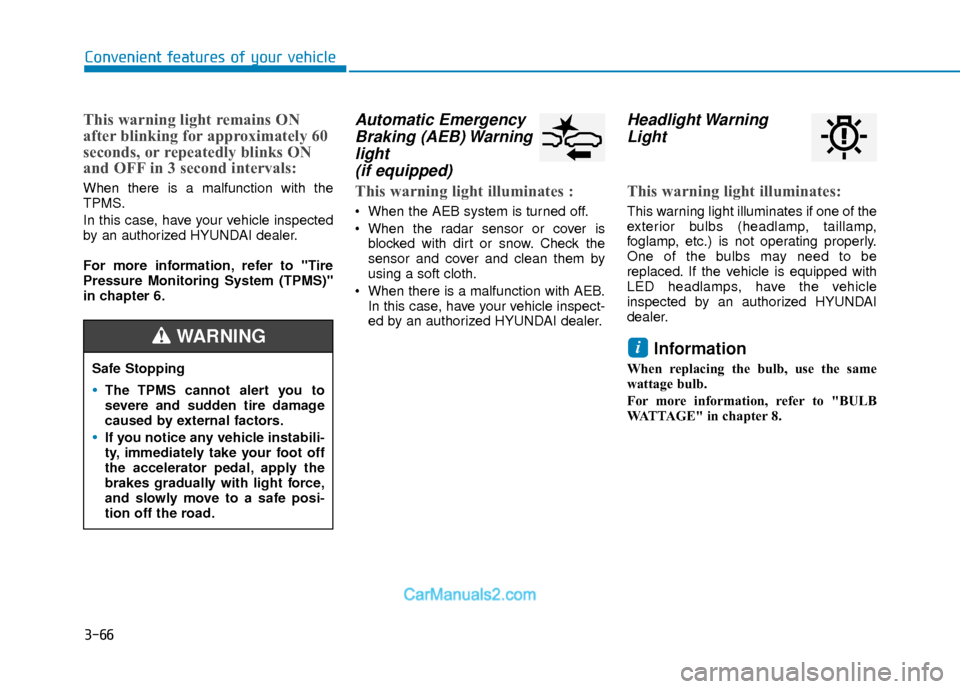
3-66
Convenient features of your vehicle
This warning light remains ON
after blinking for approximately 60
seconds, or repeatedly blinks ON
and OFF in 3 second intervals:
When there is a malfunction with the
TPMS.
In this case, have your vehicle inspected
by an authorized HYUNDAI dealer.
For more information, refer to "Tire
Pressure Monitoring System (TPMS)"
in chapter 6.
Automatic EmergencyBraking (AEB) Warninglight (if equipped)
This warning light illuminates :
When the AEB system is turned off.
When the radar sensor or cover is
blocked with dirt or snow. Check the
sensor and cover and clean them by
using a soft cloth.
When there is a malfunction with AEB. In this case, have your vehicle inspect-
ed by an authorized HYUNDAI dealer.
Headlight WarningLight
This warning light illuminates:
This warning light illuminates if one of the
exterior bulbs (headlamp, taillamp,
foglamp, etc.) is not operating properly.
One of the bulbs may need to be
replaced. If the vehicle is equipped with
LED headlamps, have the vehicle
inspected by an authorized HYUNDAI
dealer.
Information
When replacing the bulb, use the same
wattage bulb.
For more information, refer to "BULB
WATTAGE" in chapter 8.
i
Safe Stopping
The TPMS cannot alert you to
severe and sudden tire damage
caused by external factors.
If you notice any vehicle instabili-
ty, immediately take your foot off
the accelerator pedal, apply the
brakes gradually with light force,
and slowly move to a safe posi-
tion off the road.
WARNING
Page 284 of 526
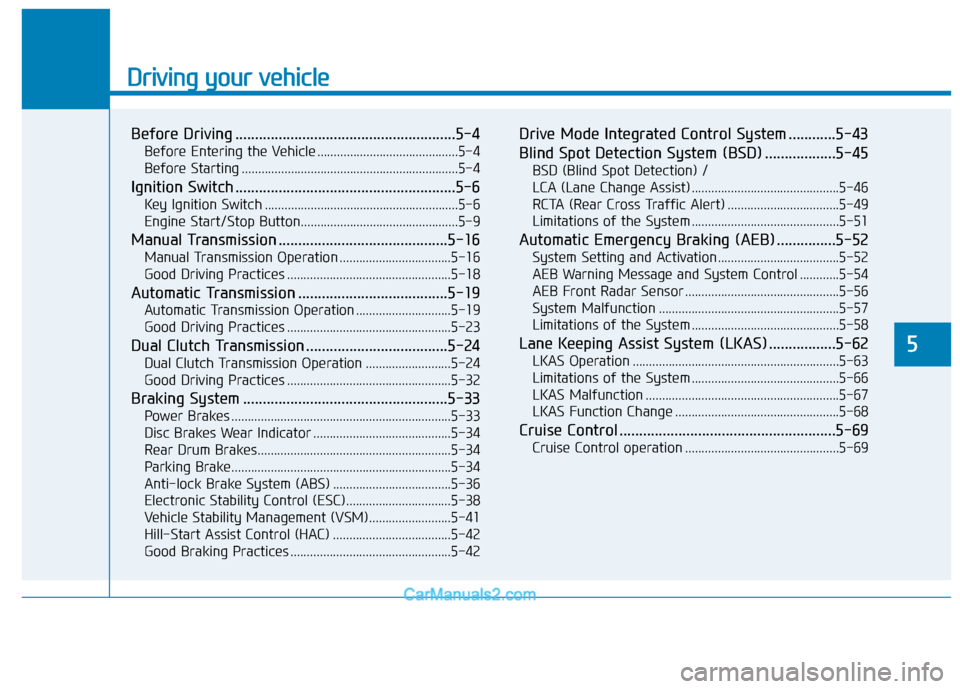
Driving your vehicle
5
Before Driving ........................................................5-4
Before Entering the Vehicle ...........................................5-4
Before Starting ..................................................................5-4
Ignition Switch ........................................................5-6
Key Ignition Switch ...........................................................5-6
Engine Start/Stop Button................................................5-9
Manual Transmission ...........................................5-16
Manual Transmission Operation ..................................5-16
Good Driving Practices ..................................................5-18
Automatic Transmission ......................................5-19
Automatic Transmission Operation .............................5-19
Good Driving Practices ..................................................5-23
Dual Clutch Transmission ....................................5-24
Dual Clutch Transmission Operation ..........................5-24
Good Driving Practices ..................................................5-32
Braking System ....................................................5-33
Power Brakes ...................................................................5-33
Disc Brakes Wear Indicator ..........................................5-34
Rear Drum Brakes...........................................................5-34
Parking Brake...................................................................5-34
Anti-lock Brake System (ABS) ....................................5-36
Electronic Stability Control (ESC)................................5-38
Vehicle Stability Management (VSM).........................5-41
Hill-Start Assist Control (HAC) ....................................5-42
Good Braking Practices .................................................5-42
Drive Mode Integrated Control System ............5-43
Blind Spot Detection System (BSD) ..................5-45
BSD (Blind Spot Detection) /
LCA (Lane Change Assist) .............................................5-46
RCTA (Rear Cross Traffic Alert) ..................................5-49
Limitations of the System .............................................5-51
Automatic Emergency Braking (AEB) ...............5-52
System Setting and Activation.....................................5-52
AEB Warning Message and System Control ............5-54
AEB Front Radar Sensor ...............................................5-56
System Malfunction .......................................................5-57
Limitations of the System .............................................5-58
Lane Keeping Assist System (LKAS) .................5-62
LKAS Operation ...............................................................5-63
Limitations of the System .............................................5-66
LKAS Malfunction ...........................................................5-67
LKAS Function Change ..................................................5-68
Cruise Control .......................................................5-69
Cruise Control operation ...............................................5-69
Page 340 of 526
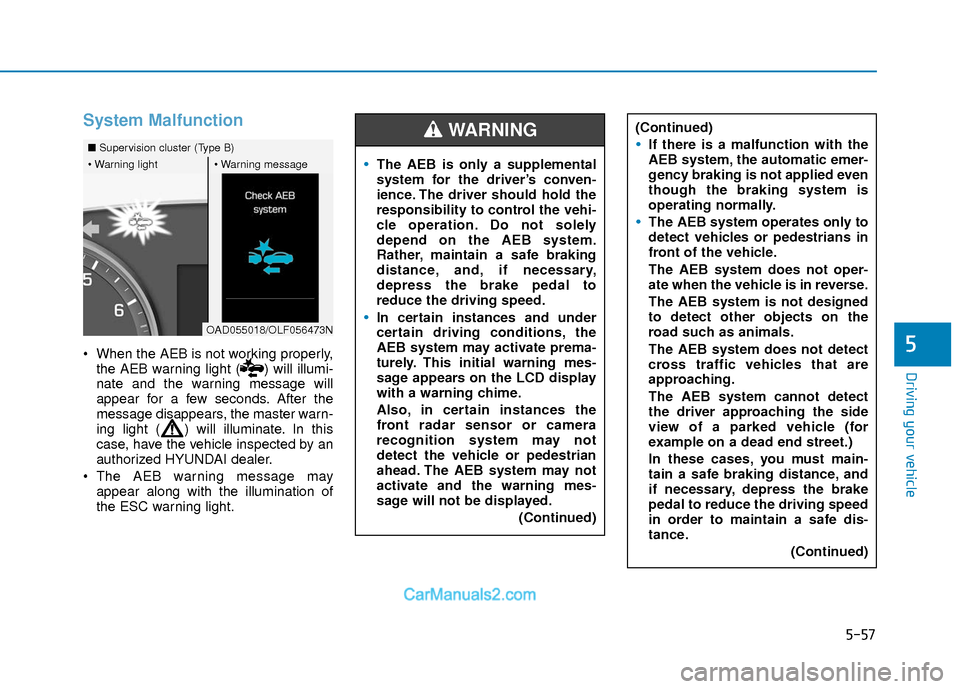
5-57
Driving your vehicle
5
System Malfunction
When the AEB is not working properly,the AEB warning light ( ) will illumi-
nate and the warning message will
appear for a few seconds. After the
message disappears, the master warn-
ing light ( ) will illuminate. In this
case, have the vehicle inspected by an
authorized HYUNDAI dealer.
The AEB warning message may appear along with the illumination of
the ESC warning light.
■ Supervision cluster (Type B)
OAD055018/OLF056473N
The AEB is only a supplemental
system for the driver’s conven-
ience. The driver should hold the
responsibility to control the vehi-
cle operation. Do not solely
depend on the AEB system.
Rather, maintain a safe braking
distance, and, if necessary,
depress the brake pedal to
reduce the driving speed.
In certain instances and under
certain driving conditions, the
AEB system may activate prema-
turely. This initial warning mes-
sage appears on the LCD display
with a warning chime.
Also, in certain instances the
front radar sensor or camera
recognition system may not
detect the vehicle or pedestrian
ahead. The AEB system may not
activate and the warning mes-
sage will not be displayed.
(Continued)
WARNING (Continued)
If there is a malfunction with the
AEB system, the automatic emer-
gency braking is not applied even
though the braking system is
operating normally.
The AEB system operates only to
detect vehicles or pedestrians in
front of the vehicle.
The AEB system does not oper-
ate when the vehicle is in reverse.
The AEB system is not designed
to detect other objects on the
road such as animals.
The AEB system does not detect
cross traffic vehicles that are
approaching.
The AEB system cannot detect
the driver approaching the side
view of a parked vehicle (for
example on a dead end street.)
In these cases, you must main-
tain a safe braking distance, and
if necessary, depress the brake
pedal to reduce the driving speed
in order to maintain a safe dis-
tance.(Continued)
Page 341 of 526
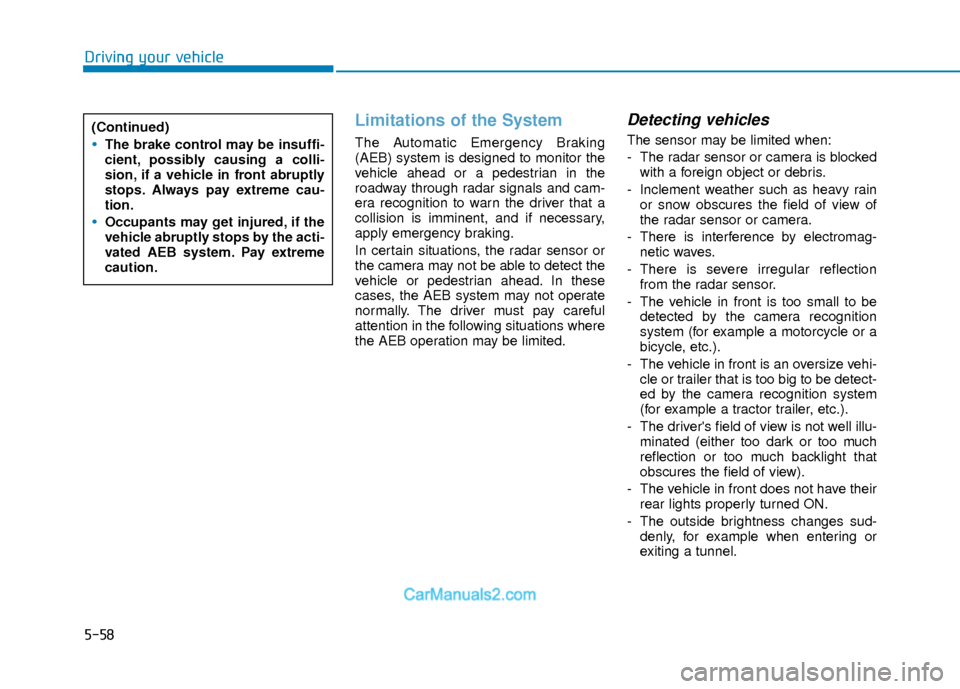
5-58
Driving your vehicle
Limitations of the System
The Automatic Emergency Braking
(AEB) system is designed to monitor the
vehicle ahead or a pedestrian in the
roadway through radar signals and cam-
era recognition to warn the driver that a
collision is imminent, and if necessary,
apply emergency braking.
In certain situations, the radar sensor or
the camera may not be able to detect the
vehicle or pedestrian ahead. In these
cases, the AEB system may not operate
normally. The driver must pay careful
attention in the following situations where
the AEB operation may be limited.
Detecting vehicles
The sensor may be limited when:
- The radar sensor or camera is blockedwith a foreign object or debris.
- Inclement weather such as heavy rain or snow obscures the field of view of
the radar sensor or camera.
- There is interference by electromag- netic waves.
- There is severe irregular reflection from the radar sensor.
- The vehicle in front is too small to be detected by the camera recognition
system (for example a motorcycle or a
bicycle, etc.).
- The vehicle in front is an oversize vehi- cle or trailer that is too big to be detect-
ed by the camera recognition system
(for example a tractor trailer, etc.).
- The driver's field of view is not well illu- minated (either too dark or too much
reflection or too much backlight that
obscures the field of view).
- The vehicle in front does not have their rear lights properly turned ON.
- The outside brightness changes sud- denly, for example when entering or
exiting a tunnel.
(Continued)The brake control may be insuffi-
cient, possibly causing a colli-
sion, if a vehicle in front abruptly
stops. Always pay extreme cau-
tion.
Occupants may get injured, if the
vehicle abruptly stops by the acti-
vated AEB system. Pay extreme
caution.
Page 342 of 526
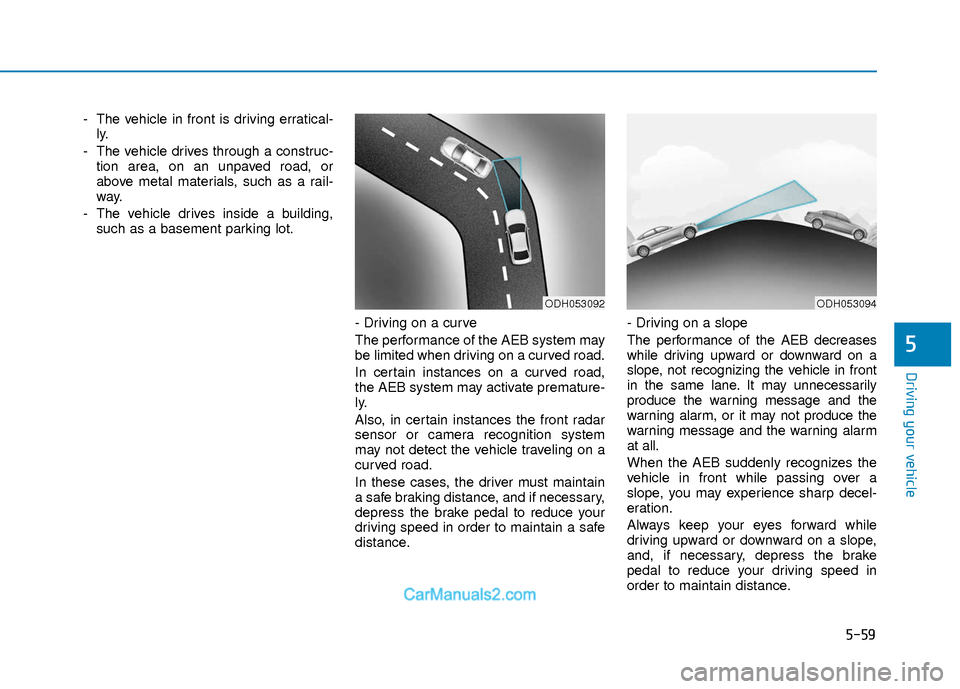
5-59
Driving your vehicle
5
- The vehicle in front is driving erratical-ly.
- The vehicle drives through a construc- tion area, on an unpaved road, or
above metal materials, such as a rail-
way.
- The vehicle drives inside a building, such as a basement parking lot.
- Driving on a curve
The performance of the AEB system may
be limited when driving on a curved road.
In certain instances on a curved road,
the AEB system may activate premature-
ly.
Also, in certain instances the front radar
sensor or camera recognition system
may not detect the vehicle traveling on a
curved road.
In these cases, the driver must maintain
a safe braking distance, and if necessary,
depress the brake pedal to reduce your
driving speed in order to maintain a safe
distance. - Driving on a slope
The performance of the AEB decreases
while driving upward or downward on a
slope, not recognizing the vehicle in front
in the same lane. It may unnecessarily
produce the warning message and the
warning alarm, or it may not produce the
warning message and the warning alarm
at all.
When the AEB suddenly recognizes the
vehicle in front while passing over a
slope, you may experience sharp decel-
eration.
Always keep your eyes forward while
driving upward or downward on a slope,
and, if necessary, depress the brake
pedal to reduce your driving speed in
order to maintain distance.
ODH053092ODH053094
Page 364 of 526
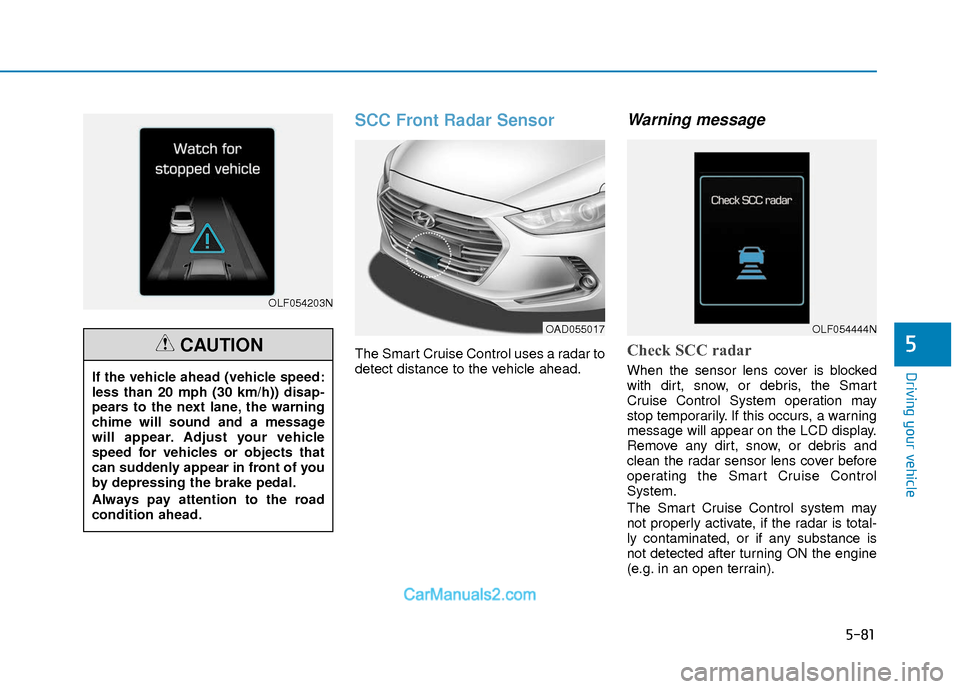
5-81
Driving your vehicle
5
SCC Front Radar Sensor
The Smart Cruise Control uses a radar to
detect distance to the vehicle ahead.
Warning message
Check SCC radar
When the sensor lens cover is blocked
with dirt, snow, or debris, the Smart
Cruise Control System operation may
stop temporarily. If this occurs, a warning
message will appear on the LCD display.
Remove any dirt, snow, or debris and
clean the radar sensor lens cover before
operating the Smart Cruise Control
System.
The Smart Cruise Control system may
not properly activate, if the radar is total-
ly contaminated, or if any substance is
not detected after turning ON the engine
(e.g. in an open terrain).
OLF054203N
If the vehicle ahead (vehicle speed:
less than 20 mph (30 km/h)) disap-
pears to the next lane, the warning
chime will sound and a message
will appear. Adjust your vehicle
speed for vehicles or objects that
can suddenly appear in front of you
by depressing the brake pedal.
Always pay attention to the road
condition ahead.
CAUTION
OAD055017OLF054444N
Page 416 of 526
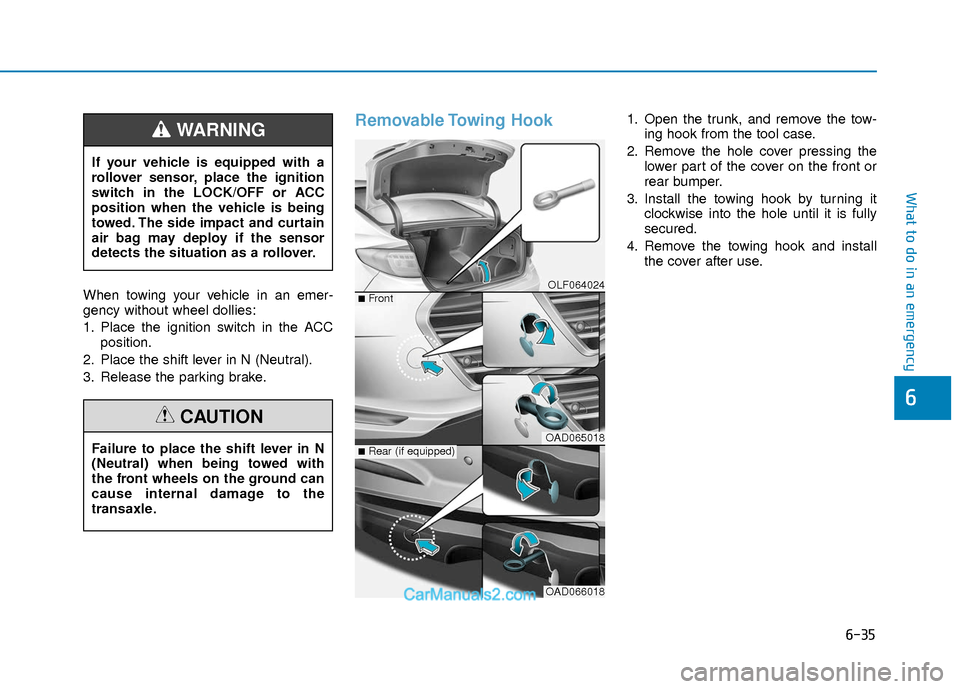
6-35
What to do in an emergency
6
When towing your vehicle in an emer-
gency without wheel dollies:
1. Place the ignition switch in the ACCposition.
2. Place the shift lever in N (Neutral).
3. Release the parking brake.
Removable Towing Hook 1. Open the trunk, and remove the tow- ing hook from the tool case.
2. Remove the hole cover pressing the lower part of the cover on the front or
rear bumper.
3. Install the towing hook by turning it clockwise into the hole until it is fully
secured.
4. Remove the towing hook and install the cover after use.
If your vehicle is equipped with a
rollover sensor, place the ignition
switch in the LOCK/OFF or ACC
position when the vehicle is being
towed. The side impact and curtain
air bag may deploy if the sensor
detects the situation as a rollover.WARNING
Failure to place the shift lever in N
(Neutral) when being towed with
the front wheels on the ground can
cause internal damage to the
transaxle.
CAUTION
OLF064024
OAD065018
OAD066018
■Front
■Rear (if equipped)
Page 494 of 526
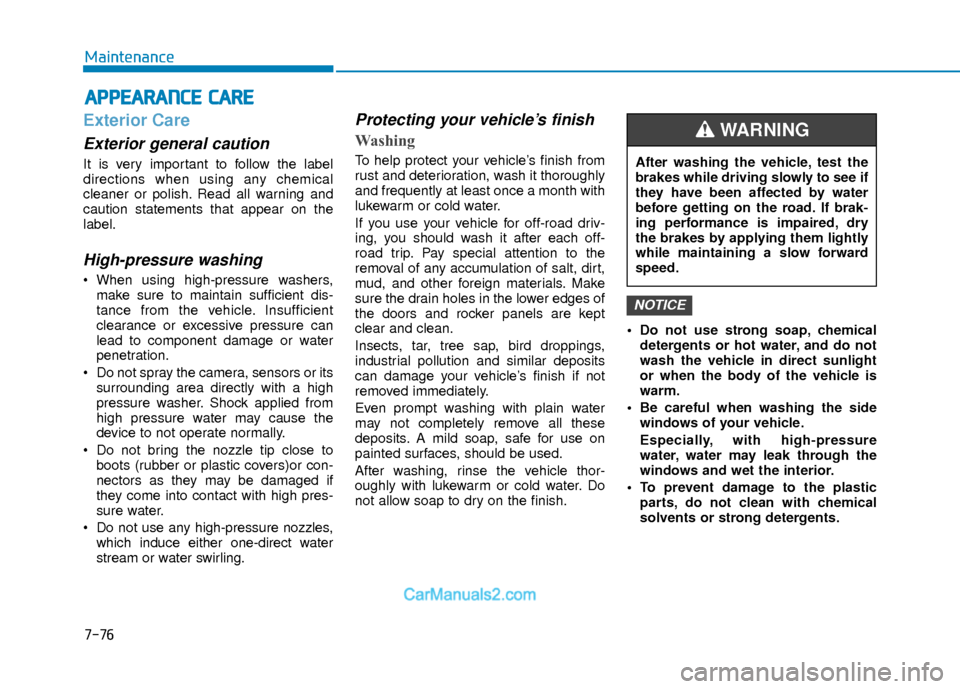
A
AP
PP
PE
EA
A R
RA
A N
N C
CE
E
C
C A
A R
RE
E
7-76
Maintenance
Exterior Care
Exterior general caution
It is very important to follow the label
directions when using any chemical
cleaner or polish. Read all warning and
caution statements that appear on the
label.
High-pressure washing
When using high-pressure washers,
make sure to maintain sufficient dis-
tance from the vehicle. Insufficient
clearance or excessive pressure can
lead to component damage or water
penetration.
Do not spray the camera, sensors or its surrounding area directly with a high
pressure washer. Shock applied from
high pressure water may cause the
device to not operate normally.
Do not bring the nozzle tip close to boots (rubber or plastic covers)or con-
nectors as they may be damaged if
they come into contact with high pres-
sure water.
Do not use any high-pressure nozzles, which induce either one-direct water
stream or water swirling.
Protecting your vehicle’s finish
Washing
To help protect your vehicle’s finish from
rust and deterioration, wash it thoroughly
and frequently at least once a month with
lukewarm or cold water.
If you use your vehicle for off-road driv-
ing, you should wash it after each off-
road trip. Pay special attention to the
removal of any accumulation of salt, dirt,
mud, and other foreign materials. Make
sure the drain holes in the lower edges of
the doors and rocker panels are kept
clear and clean.
Insects, tar, tree sap, bird droppings,
industrial pollution and similar deposits
can damage your vehicle’s finish if not
removed immediately.
Even prompt washing with plain water
may not completely remove all these
deposits. A mild soap, safe for use on
painted surfaces, should be used.
After washing, rinse the vehicle thor-
oughly with lukewarm or cold water. Do
not allow soap to dry on the finish. Do not use strong soap, chemical
detergents or hot water, and do not
wash the vehicle in direct sunlight
or when the body of the vehicle is
warm.
Be careful when washing the side windows of your vehicle.
Especially, with high-pressure
water, water may leak through the
windows and wet the interior.
To prevent damage to the plastic parts, do not clean with chemical
solvents or strong detergents.
NOTICE
After washing the vehicle, test the
brakes while driving slowly to see if
they have been affected by water
before getting on the road. If brak-
ing performance is impaired, dry
the brakes by applying them lightly
while maintaining a slow forward
speed.
WARNING
Page 524 of 526
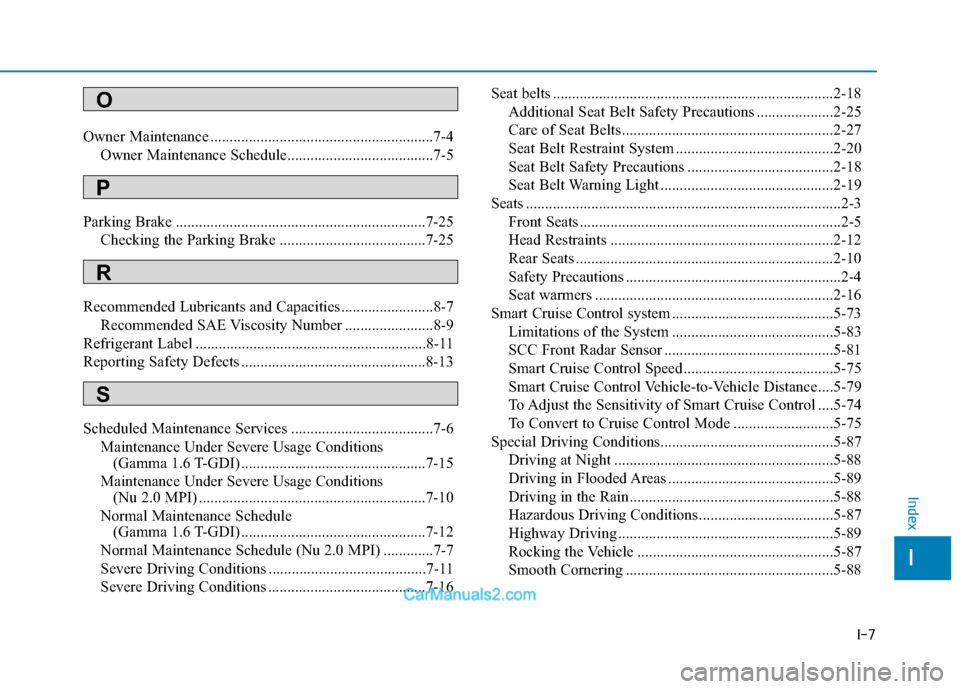
I-7
Owner Maintenance ..........................................................7-4Owner Maintenance Schedule......................................7-5
Parking Brake .................................................................7-25 Checking the Parking Brake ......................................7-25
Recommended Lubricants and Capacities ........................8-7 Recommended SAE Viscosity Number .......................8-9
Refrigerant Label ............................................................8-11
Reporting Safety Defects ................................................8-13
Scheduled Maintenance Services .....................................7-6 Maintenance Under Severe Usage Conditions (Gamma 1.6 T-GDI) ................................................7-15
Maintenance Under Severe Usage Conditions (Nu 2.0 MPI) ...........................................................7-10
Normal Maintenance Schedule (Gamma 1.6 T-GDI) ................................................7-12
Normal Maintenance Schedule (Nu 2.0 MPI) .............7-7
Severe Driving Conditions .........................................7-11
Severe Driving Conditions .........................................7-16 Seat belts ........................................................................\
.2-18
Additional Seat Belt Safety Precautions ....................2-25
Care of Seat Belts .......................................................2-27
Seat Belt Restraint System .........................................2-20
Seat Belt Safety Precautions ......................................2-18
Seat Belt Warning Light .............................................2-19
Seats ........................................................................\
..........2-3 Front Seats ....................................................................2-5
Head Restraints ..........................................................2-12
Rear Seats ...................................................................2-10
Safety Precautions ........................................................2-4
Seat warmers ..............................................................2-16
Smart Cruise Control system ..........................................5-73 Limitations of the System ..........................................5-83
SCC Front Radar Sensor ............................................5-81
Smart Cruise Control Speed .......................................5-75
Smart Cruise Control Vehicle-to-Vehicle Distance ....5-79
To Adjust the Sensitivity of Smart Cruise Control ....5-74
To Convert to Cruise Control Mode ..........................5-75
Special Driving Conditions.............................................5-87 Driving at Night .........................................................5-88
Driving in Flooded Areas ...........................................5-89
Driving in the Rain .....................................................5-88
Hazardous Driving Conditions ...................................5-87
Highway Driving ........................................................5-89
Rocking the Vehicle ...................................................5-87
Smooth Cornering ......................................................5-88
I
Index
O
P
R
S